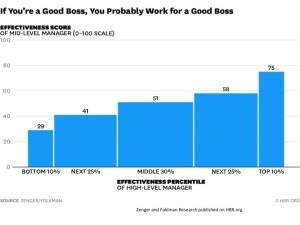Jack Zenger and Joseph Folkman published an insightful article in Harvard Business Review that validates what many of us have observed. Excellent leaders tend to cluster.
Said another way, excellent leaders develop, over time, other excellent leaders. This is a phenomenon that rings true in our every day observations. We see families that produce children of excellence, and others that do the opposite. We see cultures that produce consistent excellence and others that do the opposite.
Leadership Lesson:
This data on excellent leaders has two significant implications.
Implication #1: The number of companies with any excellent leaders is much smaller than we thought.
First is the distressing news about how few organizations or units are well run. Consider this. Gallup research indicates that America has a workforce of 100 Million. If there is a 10-1 ratio of managers to staff, for the U.S. to be perfectly managed, 10 million great supervisors would be needed and an additional 1 million great managers of those supervisors. Gallup’s research indicates that there are only about 3 million great US leaders (30% of what is needed).
If we overlay Zenger and Folkman’s research on Gallup’s findings the implications are disturbing. If excellent leaders create other excellent leaders then we know that those 3 million great supervisors are not spread equally over a large number of organizations. Instead we can expect that 2 or 3 of them are clustered together in one organization meaning that the number of US companies with great leaders is extremely small. It also means that most of us who think we are great leaders are in fact run of the mill and average at best.
Implication #2: The leadership development industry should be sued for malfeasance
If excellent leaders produce other excellent leaders then it is obvious that true leadership development comes from a relationship not training. At a time when CEOs bemoan the dearth of leaders in their pipelines and fret over who will run their companies in the years ahead, it is clear that they are overlooking the obvious. Take the leadership development budget and turn it into additional rotational positions. Assign people into those rotational positions to work directly with the few great leaders in the organization to increase exposure and the seasoning process. This would also cut down on the educated critics we are developing in leadership training whose only skill is to be able to critique what their leaders do wrong.
It is sad to see companies’ today rush like lemmings to create leadership development programs when all they are creating is knowledgeable mediocrity. Companies don’t need more leadership development or even innovation in the way leadership development is conducted. Companies just need to implement the one model that produces true results.
Copyright 9 By 9 Solutions 2016 All Rights Reserved

The Illusion of Leadership.
This comment is bi-articled including An Open Letter To Leaders,as well.
Most of the mediocre Leadership have participated in act’s of discrimination, against
Leadership qualities expounded in the Open Letter.
Fear of similar actions, directed at them, becomes the primary motivation behind duplicating what has been deemed acceptable, and go along to get along, mob mentality is ingrained as a Leadership Quality, which it is not.
Leadership should be defined by the wisdom to facilitate the individuals willing to stand alone as the Open Letter describes, in the capacity to be advantageous to application’s inherent to legal, moral and ethical issues, of that leadership.
Dennis Baker